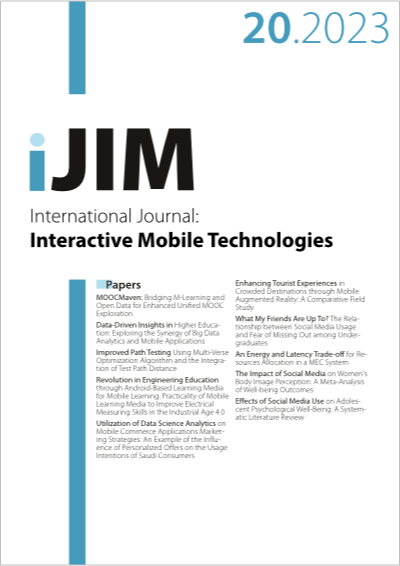Enhancing Tourist Experiences in Crowded Destinations through Mobile Augmented Reality: A Comparative Field Study
DOI:
https://doi.org/10.3991/ijim.v17i20.42273Keywords:
mobile augmented reality, human-computer interaction, cultural tourism, user performance, UNESCO heritage, crowded tourism settingAbstract
Mobile augmented reality (MAR) has gained significant attention in the tourism sector as a way to enhance the visitor experience. The rapid advancements in mobile computing and sensor technologies have facilitated the widespread use of geospatial augmented reality (AR) applications by tourists when exploring popular destinations. To analyze the impact of AR technology on the tourism experience, we developed the FEZAR mobile application. This application serves as the focal point of our study, allowing us to evaluate user performance using a comparative experimental approach. To ensure the usability of the FEZAR application, professionals with expertise in mobile technologies, including AR, performed rigorous testing and evaluation of the application. Through their evaluations, significant usability issues were identified and resolved, resulting in the application being well-received by the experts. Subsequently, a comparative field study was conducted in Fez’s old medina, a crowded UNESCO heritage site, involving users (N = 40) who were randomly assigned to experimental and control groups in equal distribution. The results of the study revealed that the proposed AR model had a significant positive impact on user visits. Compared to other forms of media, AR offers more informative and enjoyable experiences. Additionally, it effectively helps locate monuments in crowded tourism settings. The findings of this research make a valuable contribution to the ongoing discussion regarding the impact of evaluating MAR user interfaces on increasing visitor engagement with tourist destinations.
Downloads
Published
How to Cite
Issue
Section
License
Copyright (c) 2023 Mohamed Zaifri, Hamza Khalloufi, Fatima Zahra Kaghat, Abdessamad Benlahbib, Ahmed Azough, Khalid Alaoui Zidani

This work is licensed under a Creative Commons Attribution 4.0 International License.



